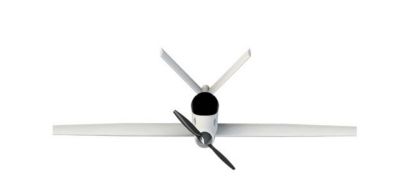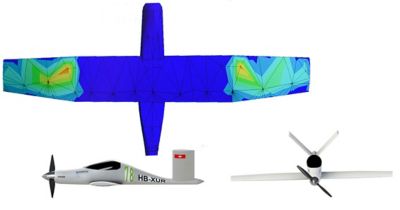-
United States -
United Kingdom -
India -
France -
Deutschland -
Italia -
日本 -
대한민국 -
中国 -
台灣
-
Ansys stellt Studierenden auf dem Weg zum Erfolg die Simulationssoftware kostenlos zur Verfügung.
-
Ansys stellt Studierenden auf dem Weg zum Erfolg die Simulationssoftware kostenlos zur Verfügung.
-
Ansys stellt Studierenden auf dem Weg zum Erfolg die Simulationssoftware kostenlos zur Verfügung.
-
Kontakt -
Karriere -
Studierende und Akademiker*innen -
Für die Vereinigten Staaten und Kanada
+1 844,462 6797
ANSYS BLOG
March 29, 2021
From an Idea to an Airplane: How One Team Is Rising to the Air Race E Challenge
How do you go from an idea to an airplane in 18 months? That was the challenge that the Pie Aeronefs SA team of Switzerland set themselves when they decided to compete in the World Championship of Electric Air Racing (Air Race E) that is due to formally start in 2022.
Air Race E involves eight small propeller airplanes taking off at once, flying to a height of about 30 feet, and racing wingtip-to-wingtip around a 2.5-mile oval defined by tall pylons on the ground at speeds of up to 250 mph. It’s the same format as Air Race 1 competitions, except the planes will be powered by electric motors instead of internal combustion engines. The aim is to rapidly advance the field of electric aircraft through a racing competition that will require teams to solve many of the challenges facing electric-powered airplanes.
Ansys is the Official Simulation Software Partner of Air Race E, providing simulation software and training to the official race teams.
This is the first in a series of blogs charting the progress of Team Pie Aeronefs as they design their plane. Read the second blog in the series here. It promises to be a daunting journey as flight testing and issuing of permits must be completed for the qualifying races that will take place later in 2021 in advance of the formal races scheduled for 2022.
The Air Race E course and a side view of the Team Pie SA UR-1 electric aircraft
Only getting started in March 2020, Pie Aeronefs SA first had to build their team before embarking on the development of the plane that summer. Unlike some of the competing teams, Team Pie Aeronefs is designing and building the airplane from scratch as opposed to starting with an existing airframe and retrofitting an electric propulsion system. While this has the advantage of enabling them to optimize the whole aircraft system, it poses major challenges for the team to go from an idea to a race plane in just 18 months. The only way they can overcome the significant engineering challenges in this time frame is by using the simulation tools provided by Ansys.
Unlike some of the teams, who come from the Air Race 1 tradition and are mainly focused on winning the World Championship of Electric Air Racing, Team Pie Aeronefs is in this for the long haul. “Our company is not planning on just this race. We’re not in the mindset just to do a race for fun,” says Timothy Kriegers, Managing Director of Marketing and Sponsorship at Pie Aeronefs SA. “By 2025 or 2026 we want to have a commercial, fully electric, four-seat general aviation aircraft we can fly for four hours at 120 knots.”
That doesn’t mean they are not interested in winning the race. “We hope to have the fastest aircraft at Air Race E,” Kriegers says.
Designing the Plane
So what challenges lay in store for the team that we will be discussing in more detail in future blog posts?
To make the most of performance and range, aerodynamics is critical. Engineers are focused on reducing the drag on the aircraft for speed and for their long-term plans to market a commercial electric plane. They have developed their UR-1 aircraft for exceptional aerodynamic properties.
Major features of interest here are the radically tapered shape of the fuselage behind the pilot, the V-tail in the rear that uses only two surfaces instead of the traditional three in a T-shaped tail to reduce drag, and the single wing spar instead of two separate wings.
Making the plane as lightweight as possible while achieving the required structural integrity is also paramount. Not visible in the imagesare the composites used to lightweight the fuselage, wings, tail and propeller.
And, of course, this is an electric aircraft. The batteries are in the wings where they are surrounded by aerospace-grade fire resistant materials for the highest possible levels of safety.
Subscribe to the Ansys blog to keep in touch with the team’s progress and we discuss each of these application areas in more detail in the coming months. But if you want a sneak peak of the team’s progress to-date, watch this fascinating time-lapse video of the build of a fuselage prototype using glass fiber composites, instead of the carbon fiber composites they will use in the actual plane.
“Our first idea was to build a fuselage model quick and cheap in glass fiber to see how it works and then adapt it afterwards,” Kriegers says. “We then cut the front to put the engine in to see how it fits. We can also put a pilot in the model to see if he can move freely to reach the flight controls and the engine controls. The integration of the components into the fuselage is important.”
Stay tuned for future updates as we dive deeper into how simulation is helping the team get to the start line on time.
Take a look at Ansys electrification solutions by downloading our new electrification e-book, “Engineering What’s Ahead: Electric Mobility.”













